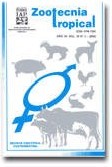
|
Zootecnia Tropical
Instituto Nacional de Investigaciones Agrícolas Venezuela
ISSN: 0798-7269
Vol. 25, No. 4, 2007, pp. 261-268
|
 Bioline Code: zt07039
Bioline Code: zt07039
Full paper language: Spanish
Document type: Research Article
Document available free of charge
|
|
|
Zootecnia Tropical, Vol. 25, No. 4, 2007, pp. 261-268
| en |
Effect of two pruning frequencies and heights on the biomass production of mulberry ( Morus alba  Linn.) Linn.)
Noda, Yolai; Martín, Giraldo; Machado, Rey; García, Danny E. & Medina, María G.
Abstract
With the objective to determine the potential yield of the mulberry variety Tigreada, two pruning heights (50 and 100 cm) and two cutting frequencies (45 and 90 days) were studied, by using of a completely randomized design at the Experimental Station of Pastures and Forages "Indio Hatuey", Cuba. The agronomic variables: dry matter yield of total biomass (TB), dry matter yield of edible biomass (EB), dry matter yield of leaves biomass (LB), and dry matter yield of fresh stems biomass (FSB) were evaluated in the rainy (RS) and dry seasons (DS) in a year of exploitation of the crop. The height by frequency interaction was significant (P<0.05); the highest values in TB were found when cutting the plant every 90 days and at 50 cm of height in the RS (134.72 g DM/plant). The interactions found in the FSB were mainly determined by the more intense pruning and the lower pruning height, and up to 13.62 g DM/plant was obtained. The cutting height showed a significant effect on TB in the DS and on LB in both periods. The highest plant production was obtained with the lowest pruning height. It is concluded that, in general, for the variables studied there was a significant interaction cutting height and frequency. With 90 days and 50 cm of pruning height, acceptable dry matter yields were achieved. An accentuated difference in terms of dry matter production was found, when mulberry it was exploited with the lowest pruning height.
Keywords
mulberry, variety, frequency, height
|
| |
| es |
Efecto de dos frecuencias y alturas de corte en la producción de biomasa de morera ( Morus alba  Linn.) Linn.)
Noda, Yolai; Martín, Giraldo; Machado, Rey; García, Danny E. & Medina, María G.
Resumen
Con el objetivo de determinar el potencial de rendimiento de la morera variedad Tigreada, se estudiaron dos alturas (50 y 100 cm) y dos frecuencias de corte (45 y 90 días), mediante un diseño totalmente aleatorizado en la Estación Experimental de Pastos y Forrajes "Indio Hatuey", Cuba. Se evaluaron las variables agronómicas: rendimiento de materia seca de la biomasa total (BT), rendimiento de materia seca de la biomasa comestible (BC), rendimiento de materia seca de las hojas (BH) y rendimiento de materia seca de los tallos tiernos (BTT) en el periodo lluvioso (PLL) y poco lluvioso (PPLL) en un año de explotación del cultivo. El efecto de la interacción altura x frecuencia fue significativo (P<0,05); los mayores valores se encontraron al cortar la planta cada 90 días y a 50 cm de altura, para la variable BT en el PLL (134,72 g MS/planta). Las interacciones encontradas en el BTT estuvieron mayormente determinadas por los cortes más intensos y la menor altura de poda y se obtuvieron hasta 13,62 g MS/planta en el PPLL. La altura de corte presentó un efecto significativo para la BT en el PPLL y la BH en ambos periodos; las mayores producciones se obtuvieron con los cortes más bajos. Se concluye que para la generalidad de las variables estudiadas existió interacción significativa de los factores altura y frecuencia de corte y con 90 días y 50 cm de poda se alcanzaron rendimientos aceptables de materia seca. Se encontró una acentuada diferencia de la morera, en términos de producción de materia seca, cuando se explotó con la menor altura de corte.
Palabras-clave
morera, variedad, frecuencia, altura
|
| |
© Copyright 2007 - Zootecnia Tropical
Alternative site location: http://www.sian.inia.gob.ve/repositorio/revistas_ci/ZootecniaTropical/ztindice.htm
|
|
